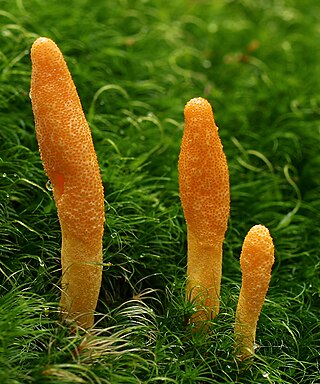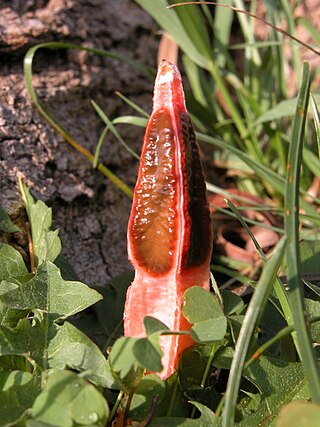
Edible mushrooms are the fleshy fruit bodies of numerous species of macrofungi. Edibility may be defined by criteria including the absence of poisonous effects on humans and desirable taste and aroma. Mushrooms that have a particularly desirable taste are described as "choice". Edible mushrooms are consumed for their nutritional and culinary value. Mushrooms, especially dried shiitake, are sources of umami flavor.

Cordyceps is a genus of ascomycete fungi that includes over 260 species worldwide, many of which are parasitic. Diverse variants of cordyceps have had more than 1,500 years of use in Chinese medicine. Most Cordyceps species are endoparasitoids, parasitic mainly on insects and other arthropods ; a few are parasitic on other fungi.

Lingzhi, Ganoderma sichuanense, also known as reishi or Ganoderma lingzhi is a polypore fungus native to East Asia belonging to the genus Ganoderma.

Aspergillus is a genus consisting of several hundred mold species found in various climates worldwide.

The genus Phallus, commonly known as stinkhorns, is a group of basidiomycetes which produce a phallic, often foul-scented mushroom, from which their name is derived. The genus has a widespread distribution and, according to a 2008 estimate, contains 18 species. They belong to the family Phallaceae in the order Phallales. The best known species is the common stinkhorn.

Oxyporus corticola, commonly known as the boring poria, is a species of fungus. It grows on hardwood and conifer logs. It has also been documented infecting humans and dogs.

Oxyporus populinus, also known as the mossy maple polypore and poplar bracket, is a species of fungus in the family Schizoporaceae. It is a plant pathogen that affects trees.
Oxyporus similis is a species of fungus in the Schizoporaceae family. A plant pathogen, it is found in the Pacific Northwest region of the United States, where it grows on the trunks of black cottonwood. It also affects peach and nectarines.
Perenniporia piceicola is a species of poroid crust fungus that is found on fallen spruce in Yunnan province, China. Basidiocarps are corky in texture, 5 cm (2 in) or more across with a characteristic pale yellow pore surface. The basidiospores are ellipsoid and hyaline and very large for the genus, up to 13 μm in length.

Oxyporus is a genus of polypore fungi in the family Schizoporaceae. An individual family Oxyporaceae was described for the genus. A number of species in this genus are plant pathogens, causing a white rot. The genus is widely distributed.

Bridgeoporus is a fungal genus in the family Polyporaceae. A monotypic genus, it contains the single polypore species Bridgeoporus nobilissimus, first described to science in 1949. Commonly known both as the noble polypore and the fuzzy Sandozi, this fungus produces large fruit bodies that have been found to weigh up to 130 kilograms (290 lb). The upper surface of the fruit body has a fuzzy or fibrous texture that often supports the growth of algae, bryophytes, or vascular plants.

Lysurus mokusin, commonly known as the lantern stinkhorn, the small lizard's claw, or the ribbed lizard claw, is a saprobic species of fungus in the family Phallaceae. The fruit body consists of a reddish, cylindrical fluted stipe that is capped with several "arms". The arms can approach or even close in on each other to form a spire. The gleba—an olive-green slimy spore mass—is carried on the outer surface of the arms. The fruit body has an odor comparable to "fresh dog feces", "rotting flesh", or "sewage" when mature.
Mycoleptodonoides is a genus of tooth fungi in the family Meruliaceae. The genus was circumscribed by M.I. Nikolajeva in 1952 with M. vassiljevae, described from Ussuri, Russia, as the type species. This fungus, known only from the type locality and northern China, is little known. The more widely distributed M. aitchisonii is found in habitats ranging from subtropical to boreal. The generic name combines the name Mycoleptodon and the Greek root -oides, meaning "resembling".

The Oxyporinae are a subfamily of the Staphylinidae discovered in 1839 by Erichson. One genus, Oxyporus Fabricius, with 132 species, is found worldwide.
Epinotia piceicola is a species of moth of the family Tortricidae. It is found in Taiwan, Japan and Russia.

Amanita sinicoflava, the mandarin yellow ringless amanita, is an edible species of fungus in the large genus Amanita.

Datroniella scutellata is a species of fungus in the family Polyporaceae, and the type species of genus Datroniella.
Psallovius piceicola is a species of plant bug in the family Miridae. It is found in North America.
Botryodontia millavensis is a species of fungus belonging to the family Phanerochaetaceae.

Tenuitholiascus is a fungal genus in the monotypic family Tenuitholiascaceae, itself in the order Strigulales. The genus contains a single species, Tenuitholiascus porinoides, a foliicolous (leaf-dwelling) lichen found in China.













